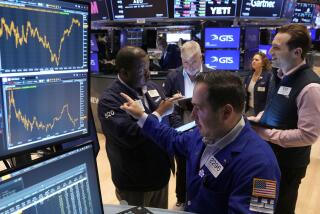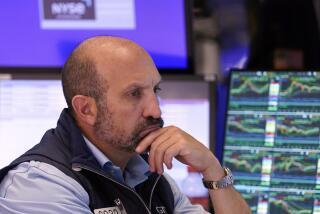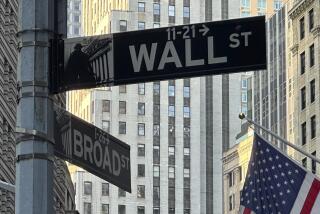Stocks swoon on interest rate fears
NEW YORK — A sudden jump in interest rates is casting a shadow over the stock market.
Stocks fell sharply Friday as a persistent rise in rates over the last month threatened to derail the powerful rally this year in share prices.
Despite notching its seventh consecutive monthly gain Friday, the Dow Jones industrial average fell more than 200 points on the last day of May as Wall Street grew increasingly alarmed at the upward trend in rates.
The yield on the 10-year Treasury note climbed to 2.13% on Friday from 1.63% on May 2. Though yields remain low by historical standards, that’s a big jump for a single month and pushed rates up to a level not seen in more than a year.
The most immediate effect of the turbulence in bonds could be increased volatility in stocks as investors try to sort out what it all means.
“It could be a bumpy ride,” said Sam Stovall, chief equity strategist at research firm S&P Capital IQ.
The big question now is what’s causing rates to jump.
Investors have long feared the potential effect on financial markets when the Federal Reserve eventually stops its purchases of government bonds, which have been aimed at spurring the economy.
Some professional investors worried that a bond-market bubble is in danger of bursting and said rates were rising in anticipation of the Fed withdrawing its support. Among other things, they feared, rising rates could stall the housing recovery.
Other experts were more sanguine, arguing that the rate surge simply reflected improved momentum in the U.S economy.
“It’s like being upset that the doctor wants to take you off the IV because you’re healing,” Stovall said. “If all the Fed is doing is tapering the [stimulus] because we’re growing organically, I would tend to think that’s a good thing.”
Jitters over the Fed’s intentions spilled into wild swings in stocks in the latter half of May.
On Friday, the Dow fell 208.96 points, or 1.36%, to 15.115.57. Prices fell especially sharply in the final few minutes of trading, though some analysts said that was largely caused by technical factors such as month-end rebalancing of stock portfolios.
Regardless, late May’s dramatic stock movements highlighted just how much the Fed’s stimulus has fueled this year’s rally. Investors get spooked — or calmed — whenever Fed officials drop hints about when the central bank might scale back its monthly $85-billion infusions into the economy.
“With the Fed’s attempt at being more transparent, they’ve also injected more uncertainty,” Stovall said.
Despite the heightened volatility, the Dow gained 1.9% in May, bringing its rise for the year to 15.4%. The blue-chip index’s performance undermined the old Wall Street adage “Sell in May, go away.”
The broader Standard & Poor’s 500 index shot up 2.1% last month, boosting its performance for the year to 14.3%. The technology-focused Nasdaq, which has lagged behind this year’s rally, did even better in May, jumping 3.8% for the month and rising 14.5% for the year.
Many investors are bracing for a potential pullback in the stock market in coming months, said Randy Frederick, managing director of active trading and derivatives at Charles Schwab.
He based that on the recent action in a widely used indicator of uncertainty, the Chicago Board Options Exchange Volatility Index, or VIX, which some refer to as Wall Street’s fear gauge.
“It means there’s a little bit of healthy skepticism out there,” Frederick said.
Many on Wall Street have been expecting the stock rally to taper off and a correction of 10% or more to set in. So far, though, stocks have easily rolled over any speed bumps, despite some triple-digit swings in intraday trading.
Last week, when Japan’s stock market plunged more than 7% in a single day, followed by sharp declines elsewhere in Asia and in Europe, major U.S. indexes dove, at first, then largely recovered.
So far this year, stocks have seen only one daily drop of 2% or more, according to Stovall. The market had three such declines last year and an average of 15 a year since 2000, he said.
Plenty could rattle investors in June. The usual trickle of economic data will drive stocks, but investors will focus first on the U.S. Department of Labor’s employment report due out Friday.
If the country’s labor market improves notably and the unemployment rate inches closer to 6.5% — a key threshold for the Fed — investors may prepare for a sooner-than-expected scaling back of the central bank’s stimulus. The U.S. unemployment rate stood at 7.5% in April.
Still, if U.S. growth boosts corporate bottom lines in the second quarter, then stocks may power higher.
Already, the nature of the stock rally has shifted.
Earlier this year, so-called defensive sectors — consumer staples and utilities, for example — outperformed the rest of the market as investors doubted the economy could sustain growth. Would-be bond buyers had little choice but to invest in stocks to get meaningful returns, given the low rates.
“That was fueled by bond buyers trying to tiptoe into the stock market, and that really didn’t build the foundation for a lasting rally,” said Jack Ablin, chief investment officer at BMO Private Bank.
But with a steady drumbeat of upbeat economic data, investors have turned toward sectors considered less safe: technology, financials and industrials.
“That’s a good sign,” said Ablin, who has his own doubts about the underlying strength of corporate profits and the overall economy. “As long as earnings and revenues and the economy follow along, we can keep the markets high.”
More to Read
Inside the business of entertainment
The Wide Shot brings you news, analysis and insights on everything from streaming wars to production — and what it all means for the future.
You may occasionally receive promotional content from the Los Angeles Times.










